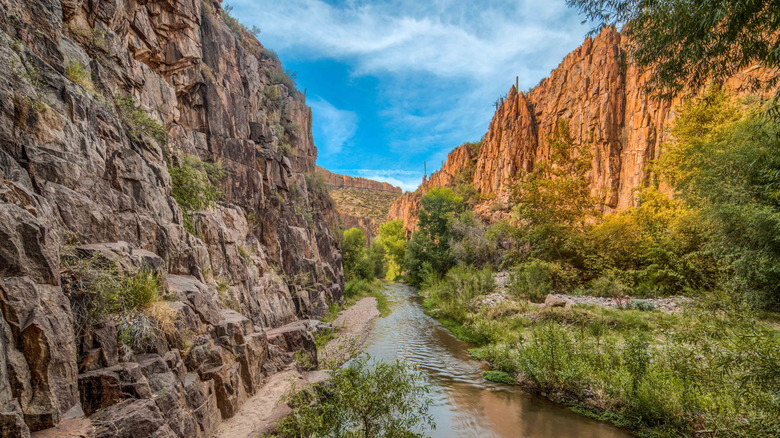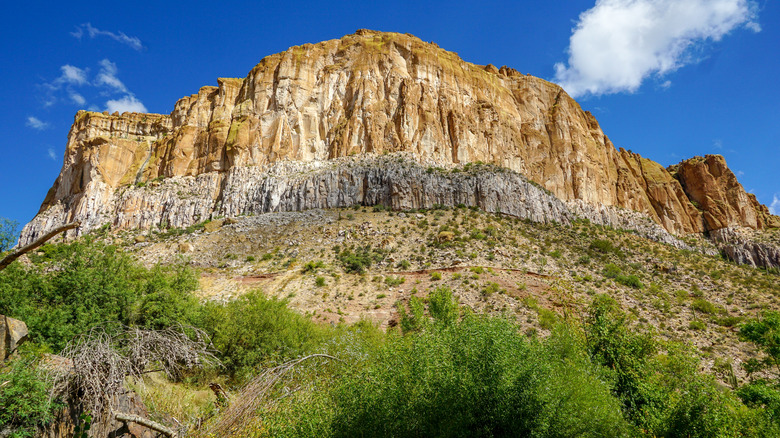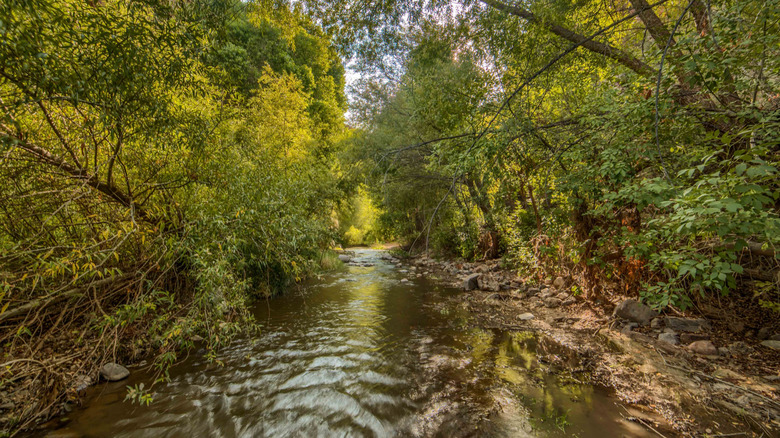
While the Grand Canyon tends to overshadow them all, Arizona is home to a seemingly endless number of lesser-known canyons where you can get lost in surreal nature and totally escape the crowds. Just a few hours from both Tucson and Phoenix is a remote, true-blue desert oasis between the Galiuro and Santa Teresa Mountains: the Aravaipa Canyon Wilderness.
Taking its name from the Western Apache word for "land of the laughing waters," the walls of this 12.25-mile-long canyon are vibrant, towering cliffs
that reach 1,000 feet tall. Inside these cliffs is a lush riparian landscape of large sycamore and cottonwood trees plus a gushing perennial stream — a goldmine in Arizona's dry desert environment, where year-round flowing waters are not at all common. Over 19,000 acres make up this wilderness area, which has no official trails or campsites. Instead, you must make your own way through the canyon by following the stream, crossing the water or climbing over rocky outcroppings when necessary.
It's possible to explore the entirety of the canyon as a 25-mile round trip, hiking the full length both ways. But many visitors opt to hike the canyon one way and arrange for a pickup at the other end, or they switch vehicle keys with friends who are hiking the canyon in the opposite direction. Otherwise, you can camp here too; all you need to do is pick a spot that's calling to you and let the magical desert canyon vibes do the rest. The number of daily visitors is carefully restricted to preserve this pristine wilderness, so you likely won't see many other people on a trip here. However, it is home to a who's who of mountain and Southwest creatures: deer, coatis, coyotes, bighorn sheep, and bears are all known to roam the canyon, so you won't be completely alone.
Read more: The 5 Best Hidden Hot Spring Hikes In California
The History And Conservation Of The Aravaipa Canyon Wilderness

Although it's possible to find solitude in the Grand Canyon, if you're really looking for a remote experience, head to the Aravaipa Canyon Wilderness. One of its most appealing aspects is that it's seemingly devoid of humans, although this wasn't always the case. Part of the reason this wilderness is protected is because of the intense damage caused by former residents, particularly in the early 20th century.
Originally inhabited by the Salado people, the canyon was later home to an Apache community. But the group was decimated during a 1871 massacre, when a vigilante band of white, Mexican, and Tohono O'odham people killed over 100 women and children in retaliation for Apache raids around the state. By the 1920s, about 700 settlers had moved into and around the canyon, destroying its ecosystem and landscape with farming, mining, and fur-trading. Then in 1969, the Aravaipa Canyon Primitive Area was declared the first protected area inside the canyon, and in 1983, the canyon was upgraded to a wilderness area, allowing the landscape to come back in a serious way. As they say, nature heals.
Today, you can hike along and (mostly) through the stream, which is home to endangered fish like loach minnow and spikedace. The riparian landscape (vegetation that grows alongside rivers or streams) is a lush paradise where you can find over 200 bird species, including rare gray hawks and yellow-billed cuckoos. Prickly pear cacti bloom from the crevasses of the dramatic red and earth-toned canyon walls, which widen to around 1,300 feet in some areas and in other areas, narrow to just around 100 feet. Best of all, you can enjoy all this nature without encountering an overwhelming human presence, thanks to the permit system that restricts the number of visitors to just 50 per day to keep the area wild.
How To Visit Aravaipa Canyon

There are two starting points to explore Aravaipa Canyon: the west and east entrances. Many choose to begin at the west entrance, which is closer to Tucson and Phoenix (1.5 and 2.5 hours, respectively). The proximity of the trailhead to two major Arizona cities means that you can fly into either of these hubs and then conveniently drive to the west side of the canyon by rental car the same day. The east entrance is nearly twice as far from both cities and access is via a rougher road that's prone to flooding, so a high-clearance vehicle or 4WD is required for safe navigation on this side. A benefit to starting at the east entrance, though, is that it offers a more remote experience, perhaps because of the effort it takes to get there and the fact that there are fewer daily permits available: 20 for the east side compared to 30 for the west entrance.
Whether hiking or camping in Aravaipa Canyon, you need a permit, which you can book online. This permit costs about $5 per person plus a non-refundable reservation fee of about $6. The permits are known to go quickly in the spring and fall and may be booked out months in advance, so it's best to snag your spot early; you can reserve/purchase your permit up to 13 weeks in advance of your trip. For those looking to camp, you can spend a maximum of three days (two nights) in the canyon. Note that pets are prohibited in this wilderness area.
Considering that Aravaipa Creek is the defining feature of this canyon, finding some good water-compatible or waterproof shoes is a must for your trip. There are multiple stream crossings throughout, and while in some areas, the water is just a few inches deep, in others it may be knee high. That means that hiking poles will come in handy, too, as they not only help you maintain balance on slippery stones but can also help you gauge the water depth as you're doing a crossing. Finally, since this is a true wilderness area, review safety tips for what to do if you encounter bears or other wildlife while hiking.
Ready to discover more hidden gems and expert travel tips? Subscribe to our free newsletter for access to the world's best-kept travel secrets.
Read the original article on Islands.













